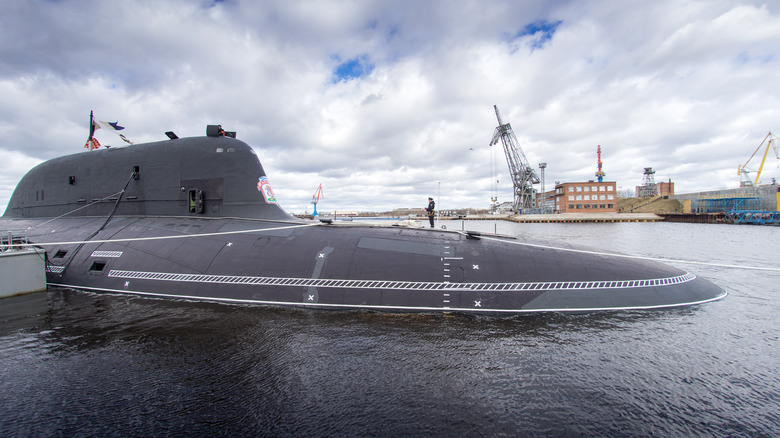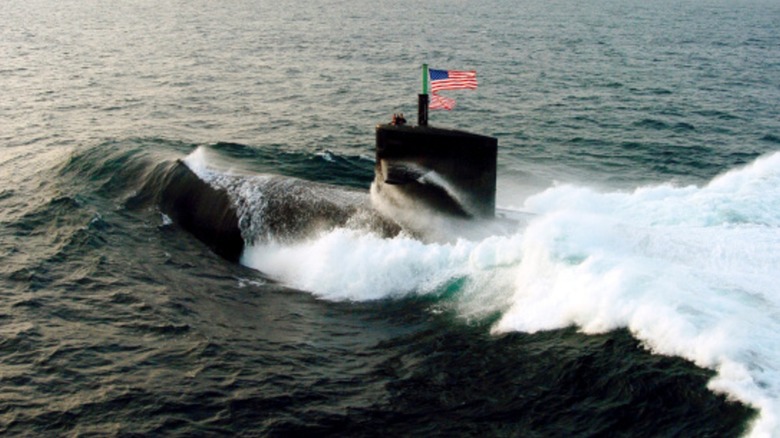What Is The Most Advanced Russian Submarine In Service Today?
The United States Navy's submarine fleet is bigger than you think, consisting of more than 70 subs, but Russia's comes in a close second with roughly 64 vessels in its arsenal. It has 16 ballistic missile submarines (often referred to as boomers), 14 nuclear-powered and 23 diesel-electric attack submarines, and 11 cruise missile subs. Its most advanced boat is the Yasen-M class – designated by NATO as the Severodvinsk-class after the name of the first in its class. U.S. Air Force General Glen VanHerck warned lawmakers that this class of guided missile submarine rivals America's fleet in terms of stealth.
U.S. Navy Vice Adm. Andrew Lewis had similar concerns a year prior, saying that these Russian boats increased the risk American sailors face in the Atlantic and that that battlespace can no longer be thought of as uncontested. The Yasen-M class boat is a subclass of the Yasen class that's roughly nine meters (29 feet) shorter for a total length of 130 meters (426 feet) and was built with an updated nuclear reactor design. It's a formidable vessel capable of launching up to three types of long-range missiles at land targets as well as adversarial surface ships from its 32 vertical launch system (VLS) tubes.
The most frightening of the three missile types is the Zircon anti-ship hypersonic missile that can travel around a mile a second. Hypersonic missiles will change war forever. If a ship detected this hypersonic missile even 100 miles out, it only gives air defense systems roughly one minute to respond.
Yasen-M submarine missiles and stealth
The Yasen-M submarines are armed with three different types of missiles, including the Zircon hypersonic missile. It's also armed with a 3M14K Kalibr subsonic missile that's comparable to America's Tomahawk cruise missile. Russia had an opportunity to test this missile in Syria during combat, where it performed well enough to begin replacing missiles on older submarines. It can also launch the P-800 Oniks supersonic missile. It's faster than the Kalibr but has a shorter range –186 miles versus 1,550 miles – but that's because its intended targets are typically surface ships.
Previous Russian submarines were built with angled VLS tubes, but the Yasen-M has modular launch VLS cylinders, allowing the Russian Navy to use a variety of missiles based on each individual situation. The Severodvinsk was able to launch a Kalibr missile while still docked in 2020 because of this modular system. Other Russian subs that carry Kalibr missiles launch them from their torpedo tubes, making it impossible to launch beside a pier.
Yasen-M subs are up there as one of the fastest submarines with a top speed of 35 knots when submerged, rivaling the unofficial speed of America's Seawolf-class attack submarines. Moreover, it can impressively dive to around 2,100 feet. While weaponry, dive depth, and speed are all concerns, what makes the Yasen-M a more significant threat than other Russian submarines is its acoustic levels, which are quieter and more on par with American submarines. The updated nuclear reactor received an improved cooling system that doesn't generate nearly as much sound as previous models.
How American submarines compare
The United States Navy's fleet is a little more robust, with over 70 submarines in total, including 14 ballistic missile subs, 53 attack subs, and four guided missile boats. Every single sub in America's fleet is nuclear-powered, allowing the military submarines to stay at sea virtually indefinitely. The Ohio and Columbia-class boats make up its ballistic missile subs, with the Ohio-class being the best unused weapon in America's arsenal. These submarines are the ones that lurk deep under the ocean's surface in complete silence as part of the country's deterrent force, waiting for the green light to launch its 24 Trident II D5LE submarine-launched ballistic missiles.
The first four Ohio subs were converted into guided missile subs as per the Strategic Arms Reduction Treaty, which limited the number of strategic missile subs to 14. The modification included converting the two forward-most missile tubes into lockout chambers for Navy SEALs to deploy from, known as Advanced SEAL Delivery System. For underwater combat, the Ohio has four torpedo tubes that launch Mark 48 torpedoes. This class is getting up there in years, as the Navy commissioned the first one in 1981, so they're set to be replaced by the newer Columbia-class boats by October 2030.
There are currently three classes of fast attack submarines in service, including the Los Angeles-class, Seawolf-class, and Virginia-class. Virginia submarines are the newest and are gradually replacing the 40-year-old Los Angeles submarines. The Virginias only have 12 VLS tubes, each capable of launching 16 Tomahawk and only four torpedo tubes.


